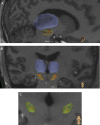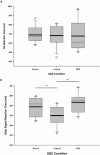Subthalamic Nucleus Subregion Stimulation Modulates Inhibitory Control
- PMID: 33381760
- PMCID: PMC7750129
- DOI: 10.1093/texcom/tgaa083
Subthalamic Nucleus Subregion Stimulation Modulates Inhibitory Control
Abstract
Patients with Parkinson's disease (PD) often experience reductions in the proficiency to inhibit actions. The motor symptoms of PD can be effectively treated with deep brain stimulation (DBS) of the subthalamic nucleus (STN), a key structure in the frontal-striatal network that may be directly involved in regulating inhibitory control. However, the precise role of the STN in stopping control is unclear. The STN consists of functional subterritories linked to dissociable cortical networks, although the boundaries of the subregions are still under debate. We investigated whether stimulating the dorsal and ventral subregions of the STN would show dissociable effects on ability to stop. We studied 12 PD patients with STN DBS. Patients with two adjacent contacts positioned within the bounds of the dorsal and ventral STN completed two testing sessions (OFF medication) with low amplitude stimulation (0.4 mA) at either the dorsal or ventral contacts bilaterally, while performing the stop task. Ventral, but not dorsal, DBS improved stopping latencies. Go reactions were similar between dorsal and ventral DBS STN. Stimulation in the ventral, but not dorsal, subregion of the STN improved stopping speed, confirming the involvement of the STN in stopping control and supporting the STN functional subregions.
Keywords: Parkinson’s disease; deep brain stimulation; inhibitory action control; subthalamic nucleus.
© The Author(s) 2020. Published by Oxford University Press.
Figures


References
-
- Alderson RM, Rapport MD, Kofler MJ. 2007. Attention-deficit/hyperactivity disorder and behavioral inhibition: a meta-analytic review of the stop-signal paradigm. J Abnorm Child Psychol. 35(5):745–758. - PubMed
-
- Alegre M, Lopez-Azcarate J, Obeso I, Wilkinson L, Rodriguez-Oroz MC, Valencia M, Garcia-Garcia D, Guridi J, Artieda J, Jahanshahi M, et al. 2013. The subthalamic nucleus is involved in successful inhibition in the stop-signal task: a local field potential study in Parkinson’s disease. Exp Neurol. 239:1–12. - PubMed
Grants and funding
LinkOut - more resources
Full Text Sources
